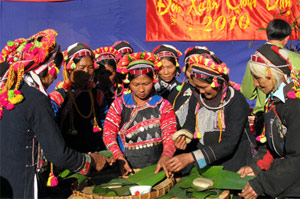
Population: 6,874 people (Year 1999)
Locality: Muong Te District of Lai Chau Province.
Customs and habits: The La Hu live in villages built on mountain slopes. These houses are level with the ground and divided by bamboo partitions. The altar for the ancestors and the kitchen are always placed in the bay of the house, which is used for the family sleeping quarters. The right of inheritance is only reserved for sons. Young men and women are free to choose their partners. After the wedding, the groom has to live with his wife’s family for several years but then takes his wife to his family house.
La Hu women usually give birth in their bedroom. Three days later, the baby is given its name. If an unexpected guest comes during this time, he or she is given the honour of naming the newborn. The worship of the ancestors is reserved for the dead parents. Every year the La Hu hold ceremonies to worship the spirits of the earth and to pray for peace. They conjure up the souls of the corn and the rice spirits after the sowing and harvesting duties have been completed.
Culture: La Hu language belongs to the Tibeto-Burman Group. There are a dozen “khen” (pan-pipe) dances in La Hu culture. The songs are sung in the Ha Nhi language, but the La Hu have kept their own rhythms. The La Hu have a rich heritage of ancient tales, and they even maintain their own calendar in which the days are defined corresponding to twelve animals, including the tiger, rabbit, dragon, mouse, sheep, monkey, rooster, dog, pig, squirrel, snake and buffalo.
Costumes: Women wear trousers and a long-lap shirt that falls to their ankles. They also wear a short vest during festive days. The collar, chest stripes, and sleeves are either embroidered or sewn with colourful pieces of cloth, silver, tin coins, or red fringes.
Economy: The La Hu live on slash-and-burn cultivation and hunting. La Hu men are very skilled at blacksmithing and making rattan chairs, trays, mats.
This post was last modified on March 8, 2018 4:50 am
Discover Vietnam is not only about discovering the landscape but also about discovering culture. One of the outstanding Vietnamese cultures…
On the theme of Vietnam's spiritual travel, in our country's culture, spirituality occupies a prominent place, playing a crucial role…
Embark on an eco-tour to Vietnam and discover renowned ancient villages. Immerse yourself in the rich culture and sustainable practices…
Da Lat has long attracted tourists with its romanticism tinged with mystery. Besides the fresh air and stunning natural landscapes,…
Phong Nha - Ke Bang National Park, a UNESCO World Heritage Site, is a fantastic place to visit for those…
Traveling to Vietnam isn't just about immersing yourself in natural beauty; it's also a golfer's paradise, offering unparalleled experiences on…
This website uses cookies.